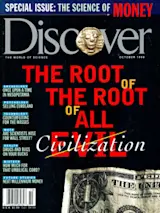As I write, I am staring at the Money Bunny. It is a brown and hairless old thing, rubbed smooth over the years, and it stares back at me with one plastic eye slightly popped. The bunny is fairly bursting. When I return from foreign trips, I empty my pockets into it, through the slot on its back. Before leaving again, however, I never remember to extract the appropriate currency. The bunny thus has a cash-flow problem.
I decide to pull the little plastic plug from its bottom. A thick bolus of British sterling stanches the flow at first, solid and heavy, each coin bearing the crowned profile of Elizabeth--as a young woman on the oldest ones, later as a handsome matron, but always and ever the Queen. German marks come next, and German eagles, strangely atavistic in a nation that today is so pacifist: on the 5-mark piece, the ...














